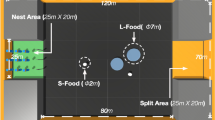Abstract
Foraging in a swarm of robots has been investigated by many researchers, where the prevalent techniques have been hand-designed algorithms with parameters often tuned via machine learning. Our departure point is one such algorithm, where we replace a hand-coded decision procedure with reinforcement learning (RL), resulting in significantly superior performance. We situate our approach within the reinforcement learning as a rehearsal (RLaR) framework, that we have recently introduced. We instantiate RLaR for the foraging problem and experimentally show that a key component of RLaR—a conditional probability distribution function—can be modeled as a uni-modal distribution (with a lower memory footprint) despite evidence that it is multi-modal. Our experiments also show that the learned behavior has some degree of scalability in terms of variations in the swarm size or the environment.












Similar content being viewed by others
Notes
The \(\epsilon \)-greedy strategy is to select a (greedy) action according to the learned Q-value function with a high probability, \((1-\epsilon )\). With the remaining small probability, \(\epsilon \), the agent selects a random action in order to explore the environment.
References
Bayindir, L. (2016). A review of swarm robotics tasks. Neurocomputing, 172, 292–321. https://doi.org/10.1016/j.neucom.2015.05.116.
Biancalani, T., Dyson, L., & McKane, A. J. (2014). Noise-induced bistable states and their mean switching time in foraging colonies. Physical Review Letters, 112(3), 038101.
Bishop, C. M. (2007). Pattern recognition and machine learning (information science and statistics). Springer.
Brambilla, M., Ferrante, E., Birattari, M., & Dorigo, M. (2013). Swarm robotics: A review from the swarm engineering perspective. Swarm Intelligence, 7(1), 1–41.
Claus, C., & Boutilier, C. (1998). The dynamics of reinforcement learning in cooperative multiagent systems. In Proceedings of the 15th national conference on artificial intelligence (pp. 746–752). AAAI Press/MIT Press.
Correll, N., & Martinoli, A. (2006). Collective inspection of regular structures using a swarm of miniature robots. In 9th int. symp. on experimental robotics (ISER) (pp. 375–385). Springer Tracts in Advanced Robotics.
Czaczkes, T. J., Grüter, C., Ellis, L., Wood, E., & Ratnieks, F. L. (2013). Ant foraging on complex trails: Route learning and the role of trail pheromones in Lasius niger. Journal of Experimental Biology, 216(2), 188–197.
Dimidov, C., Oriolo, G., & Trianni, V. (2016). Random walks in swarm robotics: An experiment with kilobots. In International conference on swarm intelligence (pp. 185–196). Springer.
Dorigo, M., Floreano, D., Gambardella, L. M., Mondada, F., Nolfi, S., Baaboura, T., et al. (2013). Swarmanoid: A novel concept for the study of heterogeneous robotic swarms. IEEE Robotics & Automation Magazine, 20(4), 60–71.
Dorigo, M., Theraulaz, G., & Trianni, V. (2021). Swarm robotics: Past, present, and future. Proceedings of the IEEE, 109(7), 1152–1165. https://doi.org/10.1109/JPROC.2021.3072740.
Essche, S. V., Ferrante, E., Turgut, A. E., Lon, R. V., Holvoet, T., & Wenseleers, T. (2015). Environmental factors promoting the evolution of recruitment strategies in swarms of foraging robots. Proceedings of the First International Symposium on Swarm Behavior and Bio-Inspired Robotics, 7, 607–613.
Ferrante, E., Turgut, A. E., Duéñez-Guzmán, E., Dorigo, M., & Wenseleers, T. (2015). Evolution of self-organized task specialization in robot swarms. PLoS Computational Biology, 11(8), e1004273.
Fujisawa, R., Dobata, S., Sugawara, K., & Matsuno, F. (2014). Designing pheromone communication in swarm robotics: Group foraging behavior mediated by chemical substance. Swarm Intelligence, 8(3), 227–246.
Gardiner, C. W. (1985). Handbook of stochastic methods (Vol. 3). Springer.
Goldberg, D., & Mataric, M. J. (1997). Interference as a tool for designing and evaluating multi-robot controllers. In AAAI/IAAI (pp. 637–642).
Goldberg, D., & Mataric, M. J. (2000). Robust behavior-based control for distributed multi-robot collection tasks. In Technical report IRIS-00-387. USC Institute for Robotics and Intelligent Systems.
Goss, S., & Deneubourg, J. L. (1992). Harvesting by a group of robots. In First European conference on artificial life (pp. 195–204).
Hamann, H. (2018). Superlinear scalability in parallel computing and multi-robot systems: Shared resources, collaboration, and network topology. In International conference on architecture of computing systems (pp. 31–42). Springer.
Hecker, J. P., & Moses, M. E. (2013). An evolutionary approach for robust adaptation of robot behavior to sensor error. In Proceeding of the fifteenth annual conference companion on genetic and evolutionary computation conference companion—GECCO ’13 companion. https://doi.org/10.1145/2464576.2482724
Hecker, J. P., & Moses, M. E. (2015). Beyond pheromones: Evolving error-tolerant, flexible, and scalable ant-inspired robot swarms. Swarm Intelligence, 9(1), 43–70.
Hoff, N., Sagoff, A., Wood, R., & Nagpal, R. (2010). Two foraging algorithms for robot swarms using only local communication. In Proc. IEEE international conference on robotics and biomimetics.
Kengyel, D., Hamann, H., Zahadat, P., Radspieler, G., Wotawa, F., & Schmickl, T. (2015). Potential of heterogeneity in collective behaviors: A case study on heterogeneous swarms. In International conference on principles and practice of multi-agent systems (pp. 201–217). Springer.
Khaluf, Y., Pinciroli, C., Valentini, G., & Hamann, H. (2017). The impact of agent density on scalability in collective systems: Noise-induced versus majority-based bistability. Swarm Intelligence, 11(2), 155–179.
Kraemer, L., & Banerjee, B. (2016). Multi-agent reinforcement learning as a rehearsal for decentralized planning. Neurocomputing, 190, 82–94.
Kumar, V., & Sahin, F. (2003). Cognitive maps in swarm robots for the mine detection application. In Proc. IEEE international conference on systems, man and cybernetics (Vol. 4, pp. 3364–3369).
Labella, T. H., Dorigo, M., & Deneubourg, J. L. (2006). Division of labor in a group of robots inspired by ants’ foraging behavior. ACM Transactions on Autonomous and Adaptive Systems (TAAS), 1(1), 4–25.
Letendre, K., & Moses, M. E. (2013). Synergy in ant foraging strategies. In Proceeding of the fifteenth annual conference on genetic and evolutionary computation conference—GECCO ’13. https://doi.org/10.1145/2463372.2463389
Liemhetcharat, S., Yan, R., & Tee, K. P. (2015). Continuous foraging and information gathering in a multi-agent team. In Proceedings of the 2015 international conference on autonomous agents and multiagent systems (pp. 1325–1333).
Llenas, A. F., Talamali, M. S., Xu, X., Marshall, J. A., & Reina, A. (2018). Quality-sensitive foraging by a robot swarm through virtual pheromone trails. In International conference on swarm intelligence (pp. 135–149). Springer.
Lu, Q., Moses, M. E., & Hecker, J. P. (2016). A scalable and adaptable multiple-place foraging algorithm for ant-inspired robot swarms. In Robotics: Science and systems conference (RSS 2016) workshop.
Mayya, S., Pierpaoli, P., & Egerstedt, M. (2019). Voluntary retreat for decentralized interference reduction in robot swarms. In 2019 international conference on robotics and automation (ICRA) (pp. 9667–9673). IEEE.
Mnih, V., Kavukcuoglu, K., Silver, D., Rusu, A. A., Veness, J., Bellemare, M. G., et al. (2015). Human-level control through deep reinforcement learning. Nature, 518, 529–533.
Pérez, I. F., Boumaza, A., & Charpillet, F. (2017). Learning collaborative foraging in a swarm of robots using embodied evolution. In Artificial life conference proceedings 14 (pp. 162–161). MIT Press.
Pinciroli, C., Trianni, V., O’Grady, R., Pini, G., Brutschy, A., Brambilla, M., et al. (2012). Argos: A modular, parallel, multi-engine simulator for multi-robot systems. Swarm Intelligence, 6(4), 271–295.
Pitonakova, L., Crowder, R., & Bullock, S. (2016). Information flow principles for plasticity in foraging robot swarms. Swarm Intelligence, 10(1), 33–63.
Pitonakova, L., Crowder, R., & Bullock, S. (2018). The information-cost-reward framework for understanding robot swarm foraging. Swarm Intelligence, 12(1), 71–96.
Poissonnier, L. A., Motsch, S., Gautrais, J., Buhl, J., & Dussutour, A. (2019). Experimental investigation of ant traffic under crowded conditions. Elife, 8, e48945.
Reina, A., Miletitch, R., Dorigo, M., & Trianni, V. (2015). A quantitative micro-macro link for collective decisions: The shortest path discovery/selection example. Swarm Intelligence, 9(2), 75–102.
Riedmiller, M. (2005). Neural fitted Q iteration: First experiences with a data efficient neural reinforcement learning method. In Proceedings of European conference on machine learning (pp. 317–328). Springer.
Saha, H. N., Das, N. K., Pal, S. K., Basu, S., Auddy, S., Dey, R., Nandy, A., Pal, D., Roy, N., Mitra, D., & Biswas, S. (2018). A cloud based autonomous multipurpose system with self-communicating bots and swarm of drones. In 2018 IEEE 8th annual computing and communication workshop and conference (CCWC) (pp. 649–653). IEEE.
Şahin, E., Girgin, S., Bayindir, L., & Turgut, A. E. (2008). Swarm robotics. In Swarm intelligence (pp. 87–100). Springer.
Schaul, T., Quan, J., Antonoglou, I., & Silver, D. (2015). Prioritized experience replay. arXiv preprint arXiv:1511.05952
Simonin, O., Charpillet, F., & Thierry, E. (2014). Revisiting wavefront construction with collective agents: An approach to foraging. Swarm Intelligence, 8(2), 113–138. https://doi.org/10.1007/s11721-014-0093-3.
Sutton, R., & Barto, A. G. (1998). Reinforcement learning: An introduction. MIT Press.
Talamali, M. S., Bose, T., Haire, M., Xu, X., Marshall, J. A., & Reina, A. (2020). Sophisticated collective foraging with minimalist agents: A swarm robotics test. Swarm Intelligence, 14(1), 25–56.
Van Hasselt, H., Guez, A., & Silver, D. (2016). Deep reinforcement learning with double q-learning. In Proceedings of the thirtieth AAAI conference on artificial intelligence.
Wang, Z., Schaul, T,, Hessel, M., Van Hasselt, H., Lanctot, M., & De Freitas, N. (2015). Dueling network architectures for deep reinforcement learning. arXiv preprint arXiv:1511.06581
Watkins, C., & Dayan, P. (1992). Q-learning: Technical note. Machine Learning, 8, 279–292.
Yogeswaran, M., & Ponnambalam, S. G. (2012). Reinforcement learning: Exploration-exploitation dilemma in multi-agent foraging task. Opsearch, 49(3), 223–236. https://doi.org/10.1007/s12597-012-0077-2.
Acknowledgements
We thank the anonymous reviewers and editors for helpful comments and suggestions. This work was supported in part by National Science Foundation Grant IIS-1526813.
Author information
Authors and Affiliations
Corresponding author
Additional information
Publisher's Note
Springer Nature remains neutral with regard to jurisdictional claims in published maps and institutional affiliations.
Rights and permissions
About this article
Cite this article
Nguyen, T., Banerjee, B. Reinforcement learning as a rehearsal for swarm foraging. Swarm Intell 16, 29–58 (2022). https://doi.org/10.1007/s11721-021-00203-8
Received:
Accepted:
Published:
Issue Date:
DOI: https://doi.org/10.1007/s11721-021-00203-8




